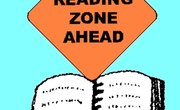Listening comprehension is a child’s ability to hear what is said by a teacher or parent and relate what he has heard to something concrete, like words on a page, actions or activities. Listening comprehension is an important part of literacy, as it is the bridge between spoken and written language. According to All About Learning Press, good listening comprehension allows a child to hear a story and understand it, retell it in his own words and discuss it with those around him.
Cluster Words For Understanding
Clustering words is a natural process in listening comprehension. As language learners begin to associate words with their meanings, rather than continuing to see and hear individual words on a page, they begin to break down speech or long passages of writing into word clusters. These have more meaning, convey a greater message than single words alone and help students begin to group words together on their own. Common word clusters include high-frequency words and site words like "I, have, am, go, has, play and you." These types of words are often clustered together to make simple sentences, begin sentences or are used as part of longer sentences. According to H.D. Brown’s “Teaching by Principles," clustering helps students pick out and comprehend manageable clusters of words rather than try to digest an entire passage.
Encourage Active Listening
Active listening helps students relate content that is being taught to meaningful activity. Florida State University’s Limelight points out that students who are interested in the subject being discussed use body language to show they are engaged. Students who take notes, look at visual aids and participate in discussions about the topic are more likely to retain knowledge from listening than those who are not actively engaged in the learning process. Active listening requires some level of background knowledge and the student’s ability to see, hear and make eye contact with the instructor.
Teach Listening Skills
Although listening is a natural part of learning for students who have no hearing deficit or language barrier, the art of listening well can be taught to increase listening comprehension. Auburn University suggests teaching listening skills by maximizing material and content that is relevant to the student’s life, using authentic language that the student can understand, varying the materials used during instruction and asking the student to perform a task related to the material to show they comprehend what is being taught.
Encourage Listening For Redundancy
Spoken language has a great deal of redundancy, and this is a good thing when it comes to increasing a student’s listening comprehension. Rephrasing of words and ideas, elaborating on content, and using phrases such as "I mean" and "You know" help students recognize repetition in language. H. Douglas Brown’s “Teaching by Principles” recommends making students aware of redundancy and repetition when it happens and looking for its signals to increase student comprehension of spoken and written language.
Related Articles
References
Writer Bio
Patti Richards has been a writer since 1990. She writes children’s books and articles on parenting, women's health and education. Her credits include San Diego Family Magazine, Metro Parent Magazine, Boys' Quest Magazine and many others. Richards has a Bachelor of Science in English/secondary education from Welch College.











